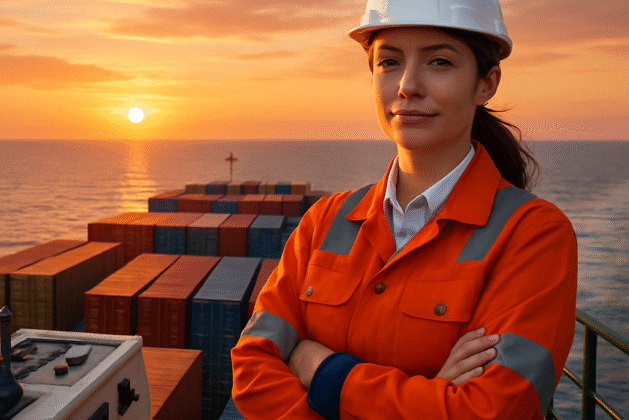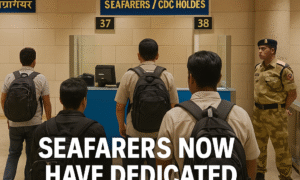The shipping industry, one of the oldest and most male-dominated sectors, is undergoing a slow but visible transformation. As part of the push toward gender equality, aligned with the United Nations Sustainable Development Goal 5, many maritime organizations are now striving to recruit and retain women in seafaring roles. But while the intent is noble, the path forward demands a closer look at both opportunities and ground realities.
Women in Maritime: The Numbers
- According to the International Maritime Organization (IMO), women represent just 1.2% of the global seafarer workforce.
- Out of this, 94% of women seafarers are employed in the cruise industry, where conditions are generally more structured and accommodating.
- In India, as per DG Shipping, the number of women with valid Continuous Discharge Certificates (CDCs) rose from around 1,200 in 2014 to over 10,000 by 2023 — a positive trend, but still a small fraction compared to the total 250,000+ active seafarers.
Despite this progress, the numbers tell us that women in core cargo shipping roles are still an exception, not the norm.
The Life at Sea: Equal Opportunity or Unequal Challenge?
Working at sea is vastly different from land-based jobs. Seafarers face long periods of isolation, erratic work hours, physical strain, and limited access to communication, often with internet limited to a few megabytes per day or restricted by time. These conditions can take a serious toll on mental health.
Women face additional layers of complexity:
- Safety concerns, especially on male-dominated vessels.
- Lack of proper accommodation (many ships still don’t have designated women’s cabins or bathrooms).
- Medical preparedness, as some ships don’t stock gender-specific health supplies unless prompted.
- Social isolation, exacerbated by the lack of access to emotional support systems.
Real-Life Cases
On one of my previous vessels, a female 3rd Officer was scheduled to join. The company proactively sent a list of female-specific medical supplies to be stocked before her arrival. Instead of the usual officer cabin, she was allocated the pilot cabin, positioned next to the Master’s quarters—reflecting how onboard arrangements still require improvisation rather than inclusive planning.
Another case I recall from my cadetship involved a female cadet who fainted during preparations for cargo hold cleaning—a physically demanding task. She was soon disembarked, allegedly for not being physically fit for the role. Though such incidents may not represent the majority, they highlight the gaps between policy and preparedness.
Celebrating Success While Staying Grounded
India is home to remarkable women like Captain Radhika Menon, the first female captain in the Indian Merchant Navy and the recipient of the IMO Award for Exceptional Bravery at Sea. Her rescue of seven fishermen from a sinking vessel in turbulent weather is a testimony to women’s capability in maritime leadership.
These stories are important—but they should not blind us to the fact that true inclusion requires systemic change.
A Balanced Approach Forward
The maritime industry cannot afford to ignore half of the population. But inclusion must come with infrastructure, support systems, and mindset changes onboard.
- Mandatory policies for safe accommodation, harassment prevention, and emergency support.
- Mental health resources and regular communication access.
- Training ship officers and crew in gender sensitivity and inclusive leadership.
- Transparent data collection and reporting on gender dynamics onboard vessels.
Conclusion
Recruiting women into shipping is a step forward—but real progress will depend on how prepared the industry is to support them at sea. Equality isn’t just about access—it’s about enabling success without compromise.
Let’s move forward with pride in our achievements, but also with honesty about our shortcomings.
Below are the websites and direct links for the references cited in the blog
1. UNCTAD: Review of Maritime Transport 2023
- Official publication and annual reports on global shipping, with comprehensive statistics and analysis.
- Website: https://unctad.org/publication/review-maritime-transport-20231
2. International Maritime Organization (IMO): Women in Maritime Reports
- IMO and Women’s International Shipping & Trading Association (WISTA) joint survey reports and gender statistics in maritime.
- Survey details and downloads: https://www.imo.org/en/OurWork/TechnicalCooperation/Pages/IMO-WISTA-Women-in-Maritime-Survey-2021.aspx2
- Full report (PDF): https://wwwcdn.imo.org/localresources/en/OurWork/TechnicalCooperation/Documents/women%20in%20maritime/Women%20in%20maritime_survey%20report_high%20res.pdf3
3. International Transport Workers’ Federation (ITF): Women Seafarers’ Health and Welfare Study
- Research on welfare, health, and working conditions for women at sea.
- Main resource and articles: https://www.itfseafarers.org/en/issues/women-at-sea/womens-health-and-wellbeing4
- Detailed survey report (PDF): https://www.itfglobal.org/sites/default/files/resources-files/women-seafarers-health-and-welfare-survey-.pdf5
4. World Maritime University (WMU): Gender Studies in Maritime
- Academic insights, dissertations, and statistics, particularly the 2019 study on women in shipping.
- Publications portal: https://wmu.se/publications?b8c8c7d6_page=36
- PhD dissertation archive: https://commons.wmu.se/phd_dissertations/7
5. WISTA International: Diversity in Maritime 2023
- News, publications, and initiatives on diversity and inclusion in the maritime sector from WISTA.
- Official site: https://wistainternational.com8
- News and definitions: https://safety4sea.com/wista-ratifies-new-definition-of-diversity-and-equity/
Have a story to share or an experience to voice? Write to us at shippys.org — a platform by and for seafarers. Anonymous entries welccome.




Leave a comment